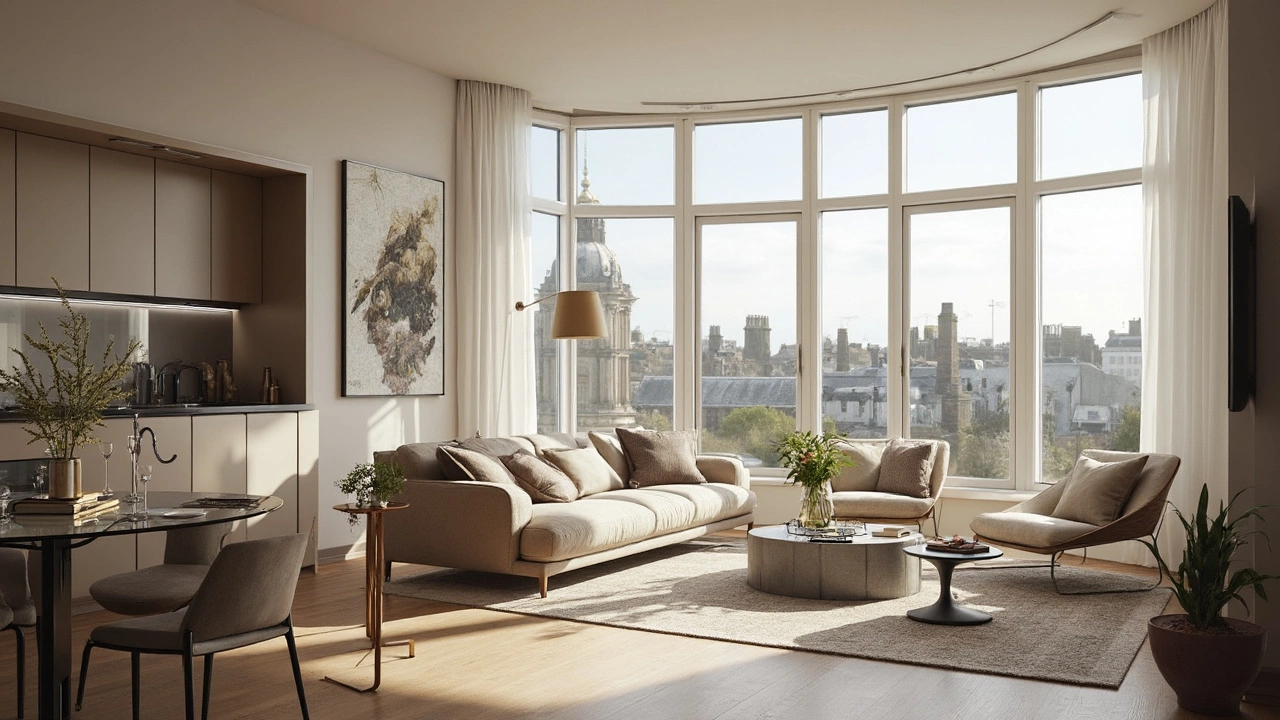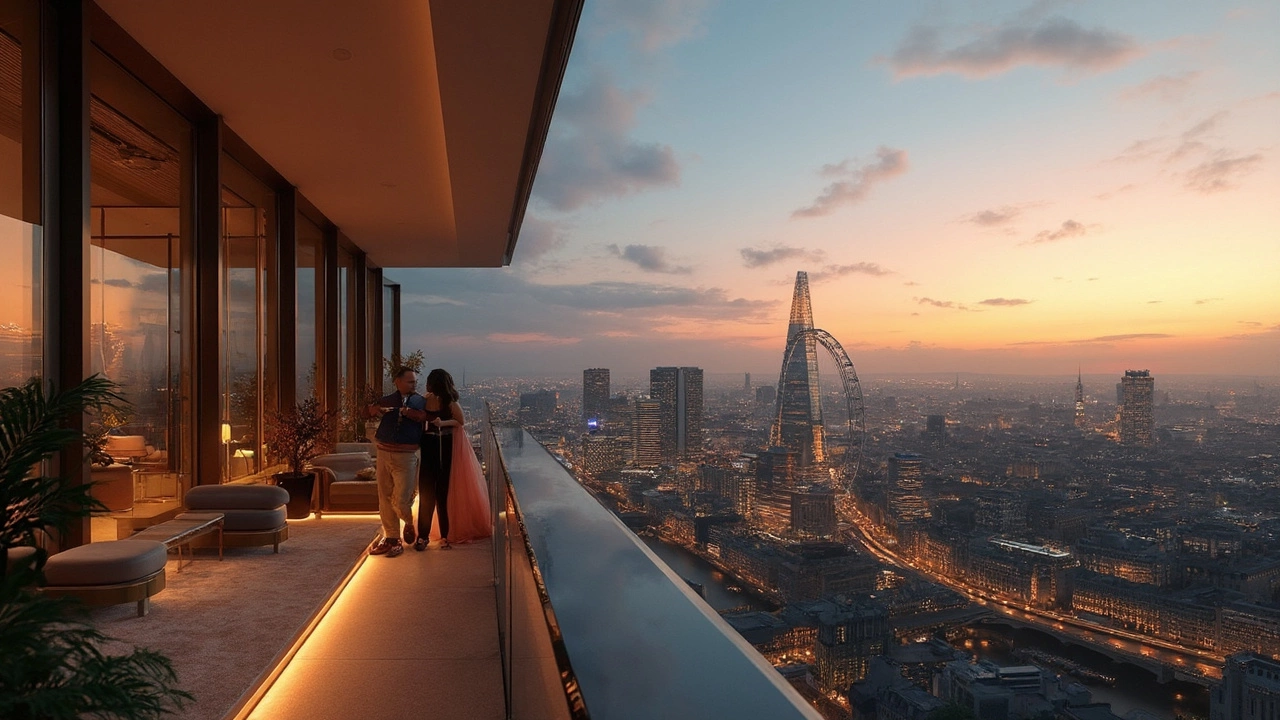Ever walked past a fancy building with doormen and private balconies, and wondered, “What do you even call those apartments?” You might hear words like “penthouse” or “luxury apartment” tossed around, but it’s not always obvious what each one really means. For most people, if it costs a fortune and the finishes are over the top, they just say it’s ‘luxury’—but there’s more to it than just a big price tag.
Here’s the lowdown: the world of expensive apartments has its own lingo. Terms like ‘penthouse’ mean something super specific—usually the top floor in a high-rise, with killer views and tons of space. Then you’ve got ‘sky lofts,’ ‘executive suites,’ and just plain ‘luxury apartments,’ each one hinting at a slightly different vibe. Picking the right word matters if you’re apartment-hunting, selling, or just trying to sound like you’ve got your finger on the pulse of city living.
- The Real Names for Expensive Apartments
- Signature Features You’ll Find Inside
- What Sets Luxury Apartments Apart
- Common Misconceptions About High-End Living
- Tips for Scoring a Top-Notch Apartment
The Real Names for Expensive Apartments
If you want to impress at a dinner party or just make sure you’re using the right words while apartment hunting, you need to know the actual terms people use for those expensive apartments. The most common label is “luxury apartment.” But not all high-priced places use this title—it’s often just the starting point.
The top tier? That’s usually the “penthouse.” Penthouses take up the whole top floor (sometimes even two!) and have the best views, the most square footage, and usually the biggest price tags in the building. If you see a listing bragging about ‘private terrace’ or ‘roof access,’ you’re probably looking at a penthouse.
“Loft apartments” or “sky lofts” are another big deal in cities like New York and Chicago. These are open-plan units that sit on high floors or former industrial buildings. When developers use a term like “executive suite” or “exclusive residence,” it’s usually all about location, high-end finishes, and private amenities, like in-building spas or smart home tech. “Ultra-luxury” and “premium apartment” get thrown around for apartments with concierge services, designer kitchens, and sometimes even private elevators.
- Penthouse: Always the showstopper. Top floor, epic views, outdoor space, maximum privacy.
- Luxury apartment: High-end everything—appliances, security, amenities, and location.
- Sky loft: Big windows, open layout, usually in converted industrial buildings, but now common in new skyscrapers too.
- Executive suite: Aimed at professionals with a taste for plush living and business-ready setups.
- Serviced residence: Think hotel-level services—cleaning, concierge, and often short-term flexibility.
The key thing to spot? Not every pricey apartment is a “penthouse” or even “luxury.” Some pricey places use words like “boutique residence” or “high-rise flat.” These terms hit different in different cities, but if the price is high and the services are next-level, you’re most likely dealing with an expensive apartment, no matter what they call it.
Signature Features You’ll Find Inside
When you step inside an expensive apartment, there’s a whole different level of attention to detail. It starts the second you walk in: ceilings are higher, windows stretch from floor to ceiling, and you’ll spot brand names that scream “top-shelf.” Most luxury apartments aren’t just about looking good—they’re about giving you a lifestyle regular rentals can’t match.
- Smart Home Tech: Forget fumbling for keys or flipping light switches. Expect remote-controlled lighting, climate, and security. Some have voice assistants hardwired throughout.
- Gourmet Kitchens: We’re talking Sub-Zero fridges, wine coolers, and restaurant-grade ranges. Islands are oversized, countertops are usually quartz or marble, and there’s always at least one built-in espresso maker.
- Private Outdoor Space: Even if it’s a city high-rise, you’ll see balconies, terraces, or even rooftop gardens just for the unit. No need to share your view with the neighbors.
- Bathroom Upgrades: Rain showers, soaking tubs, heated floors, and towel warmers are standard. If you see touchless tech or lighting that adjusts based on time of day, you’re in the right place.
- In-Unit Amenities: Things like walk-in closets, laundry rooms (not just a stackable in a closet), and built-in sound systems get their own spotlight.
Want some real numbers? Here’s what usually comes inside high-end apartments around big U.S. cities, based on a 2024 survey of top-tier buildings:
| Feature | % of Luxury Apartments Offering It |
|---|---|
| Smart Home Automation | 82% |
| Private Balcony/Terrace | 68% |
| Heated Bathroom Floors | 59% |
| Sub-Zero/Wolf Appliances | 87% |
| Dedicated Laundry Room | 65% |
Don’t forget the basics: every detail should feel a notch (or ten) above average. If you get the sense you’re walking through a luxury hotel rather than someone’s home, that’s exactly the point.

What Sets Luxury Apartments Apart
The stuff that makes a luxury apartment really pop goes way beyond a pretty kitchen. We’re talking about amenities, services, and design details you just don’t see in regular places. For starters, most luxury apartments are in top locations—think city centers, high floors with views, or swanky neighborhoods with everything close by.
Inside, you’ll notice high ceilings, floor-to-ceiling windows, hardwood or marble floors, and designer fixtures. Quartz countertops? Standard. Smart home tech? Pretty much expected. Full-sized washers and dryers, soaking tubs, and custom closets are the normal, not the exception. A lot of these buildings throw in hotel-like perks too, like shuttle services, full-time concierges, dry cleaning drop-off, and round-the-clock security.
On the community side, it’s not unusual to find:
- Rooftop pools and lounges
- State-of-the-art gyms and fitness studios
- Private movie theaters
- Guest suites for visitors
- Pet spas and dog parks
Believe it or not, a 2024 report by the National Apartment Association showed that 61% of new luxury apartment buildings include coworking spaces, and over 50% have electric car charging stations. People are also willing to shell out for security and privacy—luxury apartments are often gated or need special keycards for entry.
| Feature | % of Luxury Apartments (2024) |
|---|---|
| Smart Home Controls | 75% |
| Concierge Service | 68% |
| On-Site Fitness Centers | 88% |
| Private Outdoor Spaces | 59% |
| Coworking Spaces | 61% |
At the end of the day, it’s these touches—services you don’t have to think twice about, finishes that stand out, spaces designed for more than just living—that make luxury apartments different from the rest.
Common Misconceptions About High-End Living
People throw around ideas about luxury apartments that just aren’t true. One big myth is that anyone living in a fancy building is rolling in money. Sure, these places aren’t cheap, but not everyone inside is a millionaire. Some folks save for years or split rent with roommates just for that view or killer location.
Another common story is that a high price tag means you’re getting the best of everything. That’s not always the case. Some buildings slap on high rent just because of the neighborhood or a famous name in the lobby, not the quality of materials or amenities. You can find buildings with a great pool and gym charging less than places that just lean on their address.
People also think high-end apartments are always quiet and private. The truth? If you share walls, you’ll hear neighbors—sometimes even more in older luxury buildings with less soundproofing. Don’t assume you’re getting total peace just because the word “luxury” is on the brochure.
- Luxury apartments aren’t only in skyscrapers. You’ll find pricey pad in low-rise buildings, historic properties, or loft conversions in hip neighborhoods.
- Not every luxury apartment comes fully furnished. In many big cities, you’re expected to bring your own stuff.
- Not all amenities are truly useful. That rooftop yoga studio might look cool on Instagram, but if nobody actually uses it, you’re just paying for empty space.
If you love numbers, check out this quick table that breaks down what renters actually expect versus what’s really common:
| Feature | % of Renters Expecting | % of Apartments Offering |
|---|---|---|
| Doorman/Concierge | 73% | 58% |
| Private Outdoor Space | 68% | 41% |
| Soundproofing | 77% | 32% |
| State-of-the-Art Gym | 64% | 52% |
| Smart Home Tech | 55% | 21% |
The big take-away? Don’t let the label fool you. Do your own digging before you sign that expensive lease, and know exactly what’s included—and what’s just hype.

Tips for Scoring a Top-Notch Apartment
If you’re aiming for a place that stands out in the world of luxury apartments, you can’t just wing it. You’ve got to know how to play the game. These homes move fast, and sometimes they’re gone before you even know they're available. Here’s how smart folks lock down the best spots without losing their minds.
- Start Your Search Early: The hottest units rarely last long, especially in big cities. Begin looking two or three months before your move-in date. Landlords of luxury buildings often want tenants lined up well in advance.
- Line Up Proof of Income and References: High-end buildings almost always ask for proof you can keep up with payments. Think recent bank statements, job offers, or tax returns. Personal references help, too – some buildings even ask for them as part of the screening process.
- Tour in Person, Not Just Online: Photos rarely show you the full picture. Visit in person to see how the building feels, check out security, chat with staff, and see if the amenities (like the pool or gym) actually match the photos.
- Work with a Specialized Agent: There are real estate agents who only do luxury. They often get the inside scoop on listings before they’re posted anywhere online. A good agent will make sure you spot issues and can even help negotiate perks like waived fees or free parking.
- Ask About “Shadow Inventory”: Some luxury buildings quietly have units available but don’t post them publicly to keep up an appearance of exclusivity. If you connect with a building’s leasing office, ask directly about any units that aren’t listed yet. It can get you ahead of the crowd.
- Read Every Word of the Lease: High-end means strict rules—pet policies, guest limits, penalties for redecorating, and more. Don’t get blindsided by an unexpected rule after signing.
- Negotiate — Yes, Really: Even luxury landlords can be flexible, especially if a place has sat empty a bit too long. Don’t be shy to ask about price breaks, or getting a free month, especially outside of peak moving season.
Getting into a top-tier place means balancing speed with smart choices. With the right approach, you’ll snag a place that not only looks good online, but actually feels like home once you move in.


Corbin Fairweather
I am an expert in real estate focusing on property sales and rentals. I enjoy writing about the latest trends in the real estate market and sharing insights on how to make successful property investments. My passion lies in helping clients find their dream homes and navigating the complexities of real estate transactions. In my free time, I enjoy hiking and capturing the beauty of landscapes through photography.
view all postsWrite a comment